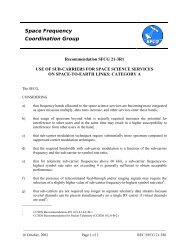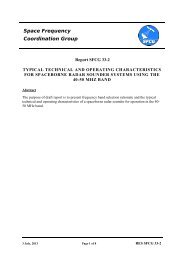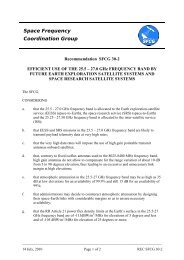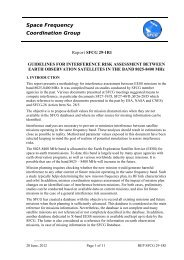REP SFCG 32-2R1 (Sharing between RNSS & EESS in 1215-1300 ...
REP SFCG 32-2R1 (Sharing between RNSS & EESS in 1215-1300 ...
REP SFCG 32-2R1 (Sharing between RNSS & EESS in 1215-1300 ...
Create successful ePaper yourself
Turn your PDF publications into a flip-book with our unique Google optimized e-Paper software.
antenna beam <strong>in</strong> azimuth 360 deg each 4.1 seconds with a 14.6 rpm rate. The azimuth beam<br />
footpr<strong>in</strong>t is observed at the ground receiver only a maximum of 300 millisec each 4.1 second<br />
period, for a reduction to the PRF by a factor of 0.073 (0.3 sec/ 4.1 sec). As a second example,<br />
Scatterometer1 switches among its three non-overlapp<strong>in</strong>g beams every 60 millisec, and then<br />
repeats the switch<strong>in</strong>g dur<strong>in</strong>g the next 180 millisec period, for a reduction to the PRF by a factor<br />
of 0.33 (60 millisec/ 180 millisec).<br />
2.8. Conclusions related to the GPS receiver protection<br />
In conclusion, the overall results of the GPS/<strong>EESS</strong> (active) study are:<br />
1) The effect of pulsed RF <strong>in</strong>terference from the two spaceborne radars Scatterometer 2 and<br />
SAR3 upon the two <strong>RNSS</strong> receivers is a change <strong>in</strong> SNR or C/N 0 of less than 0.1 dB for<br />
Scatterometer 2 and less than -1.4 dB for SAR3 for maximum RFI levels at the <strong>RNSS</strong><br />
receivers. With mitigation measures, the SAR3 degradation to SNR can be reduced from<br />
-1.4 dB to -0.1 dB.<br />
2) Account<strong>in</strong>g for the dynamics and temporal aspects of the radar antenna beam coupl<strong>in</strong>g<br />
with the <strong>RNSS</strong> antenna beam by gat<strong>in</strong>g <strong>in</strong> the test setup reduces the effective duty cycle<br />
that the RFI levels are above the <strong>RNSS</strong> receiver noise level from the transmit pulse-topulse<br />
duty cycle by a factor of about 40 for Scatterometer 2.<br />
3) Account<strong>in</strong>g for the overlap of the radar transmit spectrum with the 20 MHz wide <strong>RNSS</strong><br />
band reduces the effective pulse-to-pulse duty cycle as well. The Scatterometer 2 signal<br />
with dual 1 MHz wide frequencies is tunable and can be positioned with<strong>in</strong> the 80 MHz<br />
band from 1217.5 MHz to 1297.5 MHz. The 4 MHz wide envelope of the dual spectra<br />
would then overlap the <strong>RNSS</strong> band when close to the center of the <strong>RNSS</strong> band at 1227.6<br />
MHz.<br />
4) Account<strong>in</strong>g for the overlap of the SAR3 transmit spectrum with the 20 MHz wide <strong>RNSS</strong><br />
band also reduces its effective pulse-to-pulse duty cycle as well. The SAR3 split<br />
spectrum signal with “20 MHz + 5 MHz” has the lower duty cycle 5 MHz, 5 usec<br />
component located at the lower end of the <strong>1215</strong>-<strong>1300</strong> band centered around 1220 MHz<br />
such that the higher duty cycle 20 MHz, 20 usec component does not overlap with the<br />
GPS L2 band. The SAR3 20 MHz wide signal can be centered at 1275.5 MHz aga<strong>in</strong> with<br />
no overlap with the <strong>RNSS</strong> band. The SAR3 78 MHz wide signal is centered at 1257.5<br />
MHz with about one-fourth of its bandwidth overlapp<strong>in</strong>g the <strong>RNSS</strong> band.<br />
3-July-2013 Page 16 of 21 <strong>REP</strong> <strong>SFCG</strong> <strong>32</strong>-<strong>2R1</strong>
















